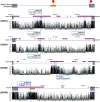This is a preprint.
Poison exon annotations improve the yield of clinically relevant variants in genomic diagnostic testing
- PMID: 36711854
- PMCID: PMC9882217
- DOI: 10.1101/2023.01.12.523654
Poison exon annotations improve the yield of clinically relevant variants in genomic diagnostic testing
Update in
-
Poison exon annotations improve the yield of clinically relevant variants in genomic diagnostic testing.Genet Med. 2023 Aug;25(8):100884. doi: 10.1016/j.gim.2023.100884. Epub 2023 May 6. Genet Med. 2023. PMID: 37161864 Free PMC article.
Abstract
Purpose: Neurodevelopmental disorders (NDDs) often result from rare genetic variation, but genomic testing yield for NDDs remains around 50%, suggesting some clinically relevant rare variants may be missed by standard analyses. Here we analyze "poison exons" (PEs) which, while often absent from standard gene annotations, are alternative exons whose inclusion results in a premature termination codon. Variants that alter PE inclusion can lead to loss-of-function and may be highly penetrant contributors to disease.
Methods: We curated published RNA-seq data from developing mouse cortex to define 1,937 PE regions conserved between humans and mice and potentially relevant to NDDs. We then analyzed variants found by genome sequencing in multiple NDD cohorts.
Results: Across 2,999 probands, we found six clinically relevant variants in PE regions that were previously overlooked. Five of these variants are in genes that are part of the sodium voltage-gated channel alpha subunit family ( SCN1A, SCN2A , and SCN8A ), associated with epilepsies. One variant is in SNRPB , associated with Cerebrocostomandibular Syndrome. These variants have moderate to high computational impact assessments, are absent from population variant databases, and were observed in probands with features consistent with those reported for the associated gene.
Conclusion: With only a minimal increase in variant analysis burden (most probands had zero or one candidate PE variants in a known NDD gene, with an average of 0.77 per proband), annotation of PEs can improve diagnostic yield for NDDs and likely other congenital conditions.
Conflict of interest statement
CONFLICT OF INTEREST
Disclosure: Dr. Kenny received personal fees from Illumina, 23andMe, and Regeneron Pharmaceuticals, and serves as a scientific advisory board member for Encompass Bio, Foresite Labs, and Galateo Bio. All other authors declare no competing interests.
Figures


References
-
- DECIPHER (DatabasE of genomiC varIation and Phenotype in Humans using Ensembl Resources) GRCh37, mapping the clinical genome [Internet] Cambridge: Wellcome Trust Sanger Institute; c2017. [cited 2022 Jan 18]. Available from: https://decipher.sanger.ac.uk
-
- Chong JX, Buckingham KJ, Jhangiani SN, Boehm C, Sobreira N, Smith JD, Harrell TM, McMillin MJ, Wiszniewski W, Gambin T, Coban Akdemir ZH, Doheny K, Scott AF, Avramopoulos D, Chakravarti A, Hoover-Fong J, Mathews D, Witmer PD, Ling H, Hetrick K, Watkins L, Patterson KE, Reinier F, Blue E, Muzny D, Kircher M, Bilguvar K, López-Giráldez F, Sutton VR, Tabor HK, Leal SM, Gunel M, Mane S, Gibbs RA, Boerwinkle E, Hamosh A, Shendure J, Lupski JR, Lifton RP, Valle D, Nickerson DA; Centers for Mendelian Genomics, Bamshad MJ. The Genetic Basis of Mendelian Phenotypes: Discoveries, Challenges, and Opportunities. Am J Hum Genet. 2015. Aug 6;97(2):199–215. doi: 10.1016/j.ajhg.2015.06.009. Epub 2015 Jul 9. - DOI - PMC - PubMed
-
- Childerhose JE, Rich C, East KM, Kelley WV, Simmons S, Finnila CR, Bowling K, Amaral M, Hiatt SM, Thompson M, Gray DE, Lawlor JMJ, Myers RM, Barsh GS, Lose EJ, Bebin ME, Cooper GM, Brothers KB. The Therapeutic Odyssey: Positioning Genomic Sequencing in the Search for a Child's Best Possible Life. AJOB Empir Bioeth. 2021;12(3):179–189. doi: 10.1080/23294515.2021.1907475 - DOI - PMC - PubMed
-
- Srivastava S, Love-Nichols JA, Dies KA, Ledbetter DH, Martin CL, Chung WK, Firth HV, Frazier T, Hansen RL, Prock L, Brunner H, Hoang N, Scherer SW, Sahin M, Miller DT; NDD Exome Scoping Review Work Group. Meta-analysis and multidisciplinary consensus statement: exome sequencing is a first-tier clinical diagnostic test for individuals with neurodevelopmental disorders. Genet Med. 2019;21(11):2413–2421. doi: 10.1038/s41436-019-0554-6. - DOI - PMC - PubMed
Publication types
Grants and funding
LinkOut - more resources
Full Text Sources
